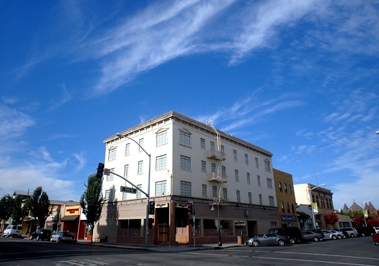
City officials adopt a wait and see approach to development
By Richard James Lopez
Special to the Pinnacle
With the passage of Measure Y on Nov. 4, and the lifting of the
sewer moratorium Dec. 5, Hollister city officials are cautiously
optimistic regarding new growth in the city’s downtown area.
City officials adopt a wait and see approach to development
By Richard James Lopez
Special to the Pinnacle
With the passage of Measure Y on Nov. 4, and the lifting of the sewer moratorium Dec. 5, Hollister city officials are cautiously optimistic regarding new growth in the city’s downtown area.
Passing with 52 percent of the vote, the measure allows for the creation of an exemption area within downtown Hollister where development can occur without affecting the citywide residential allocation limit of 244 units. The cap was set in 2002 with the passage of Measure U. The boundaries of this exemption area, as determined by RBF, the planning and design firm hired by the Hollister Downtown Association to produce the downtown strategic plan, lie roughly from North Street to Hawkins Street and McCray Street to West or Monterey streets.
The Nov. 4 election results were ratified on Dec. 1, and Measure Y is in effect.
For many in the city, the passage of Measure Y is a green light to revitalize Hollister’s downtown area.
“I see it, personally, as an opportunity for developers to take a look at downtown Hollister,” said Jeff Pyle, the economic development coordinator for the city.
Since development in the area does not count against the city’s residential cap, Measure Y “takes away the time and the money they [developers] would have spent to get allocations,” said Mary Paxton, the city’s planning manager.
The point of Measure Y is to develop mixed, high-density residential and commercial zones in order to persuade Hollister residents to spend their money in Hollister instead of traveling to other counties.
“Downtown is pretty well built up” as it is, said Pyle, yet there are still plenty of opportunities for developers, including converting vacant upper floors in existing buildings into residential units.
Ideally, the measure would lead to development that would “put more people closer to the downtown area, and, hopefully, then they would be using downtown businesses and shops,” Paxton said.
With the passage of Measure Y, “the property owners we inventoried last summer know now that they don’t have to get an allocation, they don’t have to go through that first hurdle.”
The recent lifting of the state-imposed sewer moratorium, which has been in place since the 2002 sewage spill into the San Benito River, has also been cause for optimism.
“The sewer moratorium was a major issue,” said Bill Chow, the Hollister Redevelopment Agency director. “It definitely put a halt to all development in Hollister.”
Its revocation removes yet another obstacle for developers.
Tempering the city’s optimism, however, is the current recession. By almost any measure, San Benito County has been hit particularly hard by the current economic downturn, and development in Hollister will most likely not go untouched.
“It’ll affect development everywhere,” said Chow, but for Hollister in particular, the recession is “bad timing.
“Most of the stakeholders wanted to see growth in the city when the moratorium ended,” Chow said.
According to Pyle, the current economic climate complicates the process of finding financing for development projects.
“It’s a downtime,” he said.
Nevertheless, amid the daily portents of economic gloom and doom in the national news, there are signs that there may be some light at the end of the tunnel for the city. According to Art Henriques, the Planning Director for San Benito County, a housing workshop put on by the county for first-time homebuyers two months ago in Hollister was well attended. While a couple months have passed since the approval of Measure Y, there are already signs of interest in developing in the downtown area.
“There’s one property owner [in the exemption area] that has property that’s vacant, and they’re already talking to the city about building some multi-family residential housing” Paxton said.
The real determinant of successful development in the downtown area lies outside the control of city government, Chow said.
“We need to see how the new President-elect handles the economy,” Chow said. “I think once President-elect Obama’s policies are in place,” people will be able to better gauge the direction Hollister’s downtown development will take.









